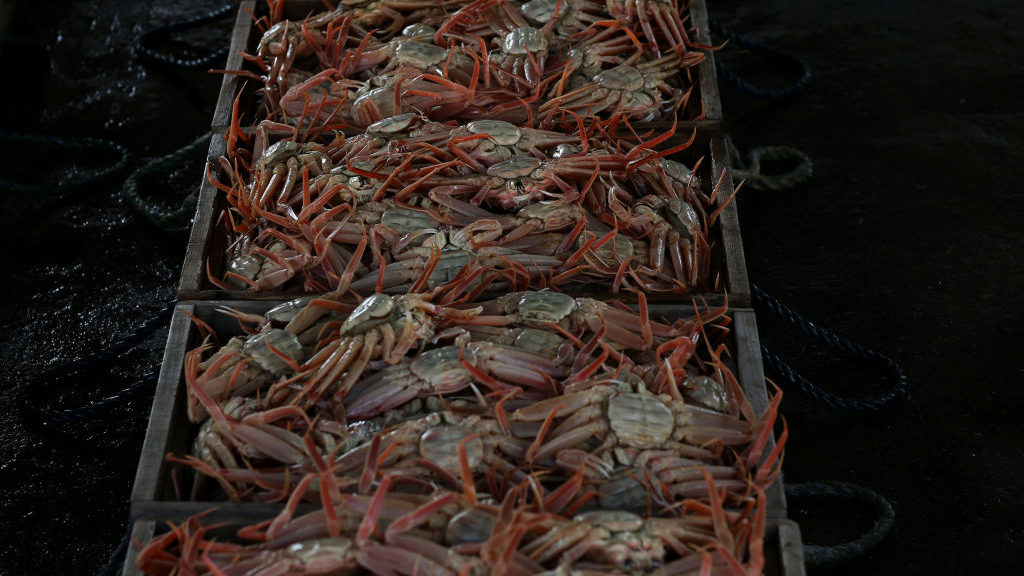
Higher water temperatures boost snow crabs’ appetites. Researchers think a heat wave caused billions of snow crabs in the Bering Sea to starve to death.
Buddhika Weerasinghe/Stringer/Getty Images News
From 2018 to 2021, an estimated 10 billion snow crabs disappeared from the eastern Bering Sea off the coast of Alaska, with the population plummeting to record lows in 2021. Researchers had only speculated as to what happened to the missing crabs. Now, a study in the Oct. 20 Science finds that a marine heat wave probably spurred a mass die-off, in part by causing crabs to starve.
“It’s a fishery disaster in the truest sense of the word,” says Cody Szuwalski, a fishery biologist at the U.S. National Oceanic and Atmospheric Administration’s Alaska Fisheries Science Center in Seattle.
On average, snow crabs bring in about $150 million of annual revenue for Alaskan fisheries. In the 2021-2022 crabbing season, that revenue fell to around $24 million. With marine heat waves becoming more common because of human-caused climate change, the future of such fisheries and arctic marine ecosystems, more broadly, is uncertain, researchers say (SN: 7/13/23).
The new research can help fishery managers anticipate and prepare for similar events such as the crab collapse in the future, Szuwalski says, particularly when it comes to getting proper disaster aid to affected fishers quickly.
Usually, cold, arctic water makes ideal habitat for snow crabs (Chionoecetes opilio) and other crustaceans. As winter’s thick sea ice melts, the frigid meltwater settles on the seafloor, creating a cold-water pool with temperatures below 2˚ Celsius. Crabs thrive in this chilly sanctuary on the eastern Bering Sea shelf. But a marine heat wave in the region in 2018 and 2019 prevented the usual amount of sea ice from forming, and, according to yearly temperature and population survey data, the cold pool never appeared and then the crab population collapsed.
Szuwalski and colleagues used computer models to analyze temperature data combined with population surveys, fishing catch numbers and lab experiments to look for drivers behind the sudden collapse. Two causes stood out: higher water temperatures and an initially dense crab population.
The water temperature probably didn’t kill the crabs directly, as snow crabs in laboratories can survive in waters up to 12° C. Instead, the crabs might have starved to death, Szuwalski says.
Data show the crab population initially boomed in 2018 — reaching historic highs — thanks to ideal ocean conditions for newborn crabs around 2010. But the crabs also occupied a smaller area than normal, though Szuwalski and colleagues are uncertain why. That means more crabs were crammed onto less space on the shelf. Then came the heat wave. Higher water temperatures can rev the cold-blooded crabs’ metabolism; previous research has shown that the calorie requirements of snow crabs in labs almost double as water temperature rises from 0° to 3° C.
As a result, the crowded crabs probably needed more food, but because of the smaller foraging area they had even fewer resources to sink their claws into. Compared with similar-sized crabs from the previous year, those surveyed in 2018 had lower body weights, another clue starvation played a role in the missing crabs.
“It’s just yet another example of something we didn’t expect, but now we have to live with,” says Christopher Harley, a marine ecologist at the University of British Columbia in Vancouver, who was not involved with the research. In the eastern Bering Sea, it could take at least four years before more crabs of a fishable size start showing up, meaning fishers there will remain in a lurch.
Such effects of marine heat waves are likely to extend beyond snow crabs. Ecosystems in northern latitudes, such as Alaska’s, are changing more rapidly in response to climate change than anywhere else (SN: 8/11/22). Scientists can typically use data from the past to help predict and prepare for changes in the future. But the future increasingly holds events that have never happened on record before — like the snow crab population collapse — so they’re harder to prepare for, Harley says.
That’s especially true, he says, because there hasn’t been enough attention on the secondary effects of marine heat waves on cold-blooded creatures, such as higher calorie needs and the risk of starvation.






